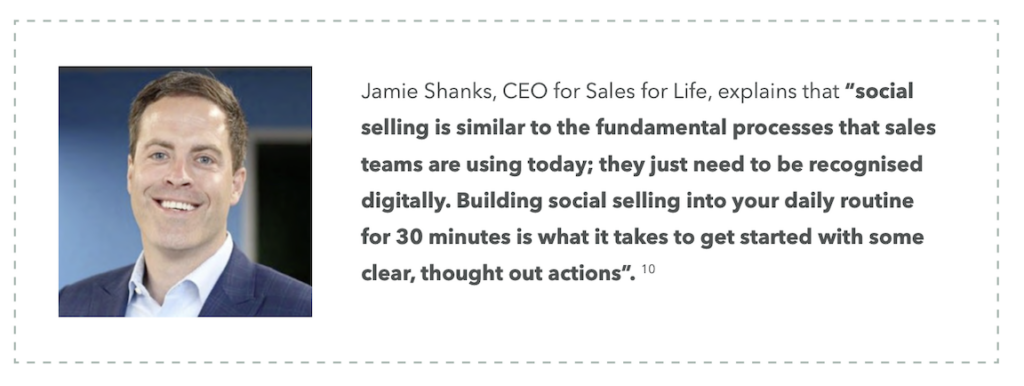The customer shift to digital means that sales leaders need to ensure their teams, at every level, are active on the platforms that their prospects are engaging with. Sales teams need to understand how they can add value, engage in the conversation and provide the right information at the right time to potential customers.
Decision-makers regularly scan social media sites for relevant content, reviews and information on possible products or services before purchasing. Hence, it is about identifying those crucial moments and being present in the conversation.
Scale of challenge
Understanding that not every seller in the business knows how to sell online is crucial. Only 1 in 4 salespeople currently know how to integrate social selling into their process, which indicates the work still to do to educate teams on the best approach and tools to be effective.9 On the flip side, it provides an opportunity for businesses to start a social selling programme and not be left behind.
It is also crucial to gain buy-in from the sales team to make the programme a success. Bringing the team on a journey and explaining why this is an essential tool for their toolbox, including the benefits and expected outcomes, will build engagement from the outset and, as a result, is more likely to make the programme a success.

There is no set framework for creating a social selling strategy as every business is different; however, some fundamental principles and considerations should be worked through to make the programme a success. It is a good idea for businesses to start small by running a pilot to understand what does and does not work and then scaling up at the right time.
Here is a suggested framework:
1. Identify goals for the programme.
For a social selling programme to work, the sales team must understand its goals and what they are trying to achieve. This will be the motivator behind the programme, and clearly articulating this upfront is crucial. The objectives could be centred around broadening the customer base, expanding into a new target segment, strengthening relationships with new buyers at key accounts or all of the above. Writing clear, specific objectives will make it much easier to report success at the end of the programme.
2. Establish clear roles of responsibility
It is essential to get buy-in upfront for a social selling programme to work. Having a senior leader in the company sponsor the programme and drive engagement is a great way to inspire sales teams to get involved. Mapping out defined roles and responsibilities for areas such as upskilling on best practices across social media networks, building a content pipeline and tracking and analysing the programme’s success will help bring the team together to deliver the programme smoothly. These responsibilities are typically shared between the sales and marketing team – collaboration is the key to success.
3. Launch a training programme
Only one in four salespeople know how to incorporate social selling into their day jobs. Therefore, launching a training programme is a sensible way to ensure that everyone understands how to use social media to build relationships and sell practically. There are four pillars to effective social selling: building a personal brand, finding prospects, engaging with insights and building trusted relationships. Providing practical training on how sales teams can incorporate this structure into their approach will help drive effectiveness.
| Building a personal brand To forge meaningful relationships with potential customers, they need to know who the individual is and their areas of expertise. When they have a challenge, that person pops to mind as the solution. This requires an individual to build an authentic profile across the platforms where their customers exist, with key information on experience and interests. | Finding prospects Finding prospects is about identifying whom the decision-makers and influencers are and using social listening techniques to find and connect with them on the most relevant social media platforms. | Engaging with insights Individuals can position themselves as subject matter experts by sharing relevant industry content, commenting on news alerts and building a professional brand. It is about creating a conversation based on all data types and contextualising the content for the customer. | Build trusted relationships Individuals can build trust with customers by sharing their perspectives and providing relevant information to common pain points. It is important to have genuine conversations and focus on the customer’s needs first and selling second. |
Once the training programme is outlined, the next step is to identify who will deliver the training and how.
4. Consider the customer journey
This step is where marketing’s role is critical. Social selling is only one part of the customer lifecycle, and there will no doubt be marketing activity running simultaneously to the programme. The sales team needs to understand what activity is planned, including content in development, and how their efforts across social media support this. Customers will be interacting with the brand at multiple touchpoints before the sales team starts to engage with them, so it is important to be joined up and provide one consistent customer experience.
5. Encourage collaboration
Collaboration will underpin the success of the programme in many ways. Firstly, the team must regularly communicate about whom they are targeting and connecting with to avoid doubling their efforts and bombarding clients. Secondly, having a process in place for continuous feedback regarding what the sales team is hearing from clients will allow the team to optimise the content and insights to be more relevant. This will drive greater results.
6. Measure success
Finally, all of this does not count unless the team tracks progress, new connections, conversations and sales on a customer relationship management (CRM) system. This will be a crucial tool in optimising the programme and proving return on investment (ROI). Revisiting the programme objectives and looking at the data will help teams to persuade and influence others that social selling is a crucial strategy for business success.


















